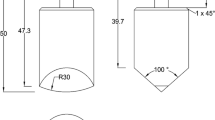Abstract
The response of four rocks, namely granite, rhyolite, limestone and schist, to indentation by blunt cutting tools is discussed from a contact mechanics point of view. Contact forces between 0.1 kN and 2.45 kN are applied; indenter sizes are 1.0 and 5.0 mm, respectively. A transition from elastic to elastic-plastic response exists which depends on rock hardness and on indenter size. Blunt indenters promote elastic response; soft rocks tend to elastic-plastic response. In the elastic-plastic range, depression radius has a linear relationship to the indenter radius. Radial cracking occurs in soft rocks leading to strength degradation in the near surface regions. Sharp indenters promote radial cracking. The relationship between length of radial cracks and contact force is non-linear. Lateral cracking occurs in soft rocks leading to material removal. Sharp indenters promote lateral fractures. Anisotropy and non-homogeneity affect the material response notably. The ratio between fracture toughness and hardness (`index of brittleness') is a promising parameter to evaluate the behaviour of rock materials in excavation, drilling and fragmentation processes.
Similar content being viewed by others
References
Auerbach, F. (1891). Absolute Härtemessung. Annalen der Physik und Chemie Bd. XLIII 61–100.
Boccaccini, A.R. (1999). The relationship between wear behaviour and brittleness index in engineering ceramics and dispersion-reinforced ceramic composites. Interceram 48, No. 3, 176–187.
Bushby, A.J. and Swain, M.V. (1995). Spherical indentations as a means for investigating the plastic deformation of ceramics. In R.C. Bradt et al. (eds.) Plastic Deformation of Ceramics, Plenum Press, New York pp. 161–172.
Frank, F.C. and Lawn, B.R. (1967). On the theory of Hertzian fracture. Proceedings Royal Society of London A299 291–306.
Goodman, R.E. (1989). Introduction to Rock Mechanics. Wiley & Sons, New York.
Guiberteau, F. Padture, N.P. and Lawn, B.R. (1994). Effect of grain size on Hertzian contact damage in alumina. Journal of American Ceramic Society 77, 1825–1831.
Johnson, K.L (1985). Contact Mechanics. Cambridge University Press, London.
Kuo, S.Q. Lindquist, P-.A. and Tan, X.C. (1995). An analytical and experimental investigation of rock indentation fracture. In T. Fujii (ed.) Proceedings 8th International Congress on Rock Mechanics. Vol. 1, Int. Soc. of Rock Mechanics, Tokyo pp. 181–184.
Lawn, B.R. (1993). Fracture of Brittle Solids. Second Ed., Cambridge University Press, Cambridge
Lawn, B.R., Evans, A.G. (1977). A model for crack initiation in elastic/plastic indentation fields. Journal of Materials Science 12, 2195–2199.
Lindquist, P.-A., Lai, H.H. and Alm, O. (1984). Indentation fracture development in rock continuously observed with a scanning electron microscope. International Journal Rock Mechanics Mining Science & Geomechanics Abstracts 21, 165–182.
Liu, H.Y., Kou, S.Q., Lindquist, P.-A. and Tang, C.A. (2002). Numerical simulation of the rock fragmentation process induced by indenters. International Journal Rock Mechanics and Mining Science 39, 491–505.
Marshall, D.B., Lawn, B.R. and Evans, A.G. (1982). Elastic/plastic indentation damage in ceramics: lateral crack system. Journal American Ceramic Society 65, 561–566.
Mouginot, R. and Maugis, D. (1985). Fracture indentation beneath flat and spherical punches. Journal of Materials Science 20, 4354–4376.
Murakami, Y. (1987). Stress Intensity Handbook. Vol. 1, Pergamon Press, Oxford pp. 13–15.
Peter, K. (1964). Sprödbruch und Mikroplastizität von Glas in Eindruckversuchen. Glastechnische Berichte 37, 333–345.
Swain, M.V. and Lawn, B.R. (1976). Indentation fracture in brittle rocks and glasses. International Journal Rock Mechanics Mining Science & Geomechanics Abstracts 13, 311–319.
Tabor, D. (1951). Hardness of Metals. Clarendon, Oxford.
Tan, X.C. Kou, S.Q. and Lindquist, P.-A. (1998). Application of the DDM and fracture mechanics model on the simulation of rock breakage by mechanical tools. Engineering Geology 49, 277–284.
Unland, G. and Meltke, K. (1999). Die Brechbarkeit von Kalkstein und Mergel. ZKG International 52, 337–342.
von Karman, T. (1911). Festigkeitsversuche unter allseitigem Druck. Zeitschrift des VDI Bd. 55, Nr. 42, 1749–1757.
Widjaja, S., Ritter, J.E. and Jakus, K. (1996). Influence of R-curve behaviour on strength degradation due to Hertzian indentation. Journal of Materials Science 31, 2379–2384.
Author information
Authors and Affiliations
Rights and permissions
About this article
Cite this article
Momber, A. Deformation and fracture of rocks loaded with spherical indenters. International Journal of Fracture 125, 263–279 (2004). https://doi.org/10.1023/B:FRAC.0000022240.64448.2f
Issue Date:
DOI: https://doi.org/10.1023/B:FRAC.0000022240.64448.2f




